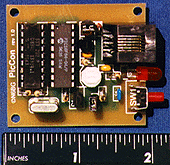
- The SquawkBox from Bob Simmons WB6EYV puts out about 25 milliwatts. It includes a voice chip and miniature microphone that records and sends your voice ID and short voice messages at adjustable periodic intervals. The frequency is pre-programmed and cannot be easily changed, but many frequencies in the two-meter band are available. SquawkBox was reviewed in my Homing In column for the Spring 2005 issue of CQ-VHF Magazine.
- The MicroHunt is also made and sold by Bob Simmons. It sends standard Morse Code ARDF messages (MOE/MOI/MOS) in tone-modulated FM, with standard IARU timing. Frequency options are the same as the Squawkbox. Bob programs your callsign into the Microhunt before shipping. A two-watt RF amplifier for Squawkbox or MicroHunt is also available from WB6EYV.
- The Micro-Fox 50 from Byonics is a frequency-synthesized two-meter transmitter adjustable up to 50 milliwatts that can send unique tone sequences for mobile T-hunts or MOE/MOI/MOS messages for ARDF. Frequency, timing, callsign ID and tone patterns are entered from a PC via a serial connection and held in non-volatile memory.
- For longer distance hunts, Byonics sells the Micro-Fox PicCon (MF-PC) that covers the entire two-meter band. With its built-in receiver, it can be remotely controlled with DTMF tones like PicCon. The receive frequency can be different from the transmit frequency. It can also be programmed via its serial port like the Micro-Fox 50. MF-PC will operate for about 20 hours on three AA batteries with transmit cycle of 50 per cent or less. Claimed power output is 700-milliwatts with fresh batteries, dropping as battery voltage falls. It will operate longer at lower power on two AA batteries. The MF-PC internal clock has a ceramic resonator, but the firmware includes a programmable correction factor to minimize timing drift in a multiple-fox hunt.
-
The HackerBox Fox Hunt Kit includes all of the parts to build a two-meter or 70 centimeter band hidden transmitter using a SA818 radio transceiver module with harmonic filter and ESP32 microcontroller. Online instructions and a video provide help with construction.
- The Mid-Power UHF FM Beacon by BigRedBee LLC of Lake Oswego, OR (Greg Clark K7RKT, owner) is actually for the two-meter VHF band. It is programmable up to one watt and includes a buck-boost regulator to keep output power constant as battery voltage sags. (Battery not included.) Programming is by serial interface. The company also sells miniature transmitters for the 70 centimeter UHF band.
If your fox transmitter is on a single board, like SquawkBox, HackerBox and Big Red Bee, you will need to mount it into your own weatherproof enclosure with a battery and power switch, perhaps in camouflage. A SquawkBox in a black plastic case is shown opened up in the photo above right.
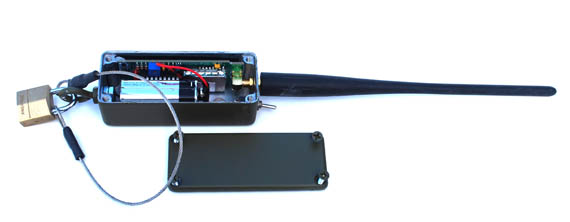
I built this Byonics Micro-Fox into in a die-cast metal box with a piano-wire lanyard and lock to prevent theft.
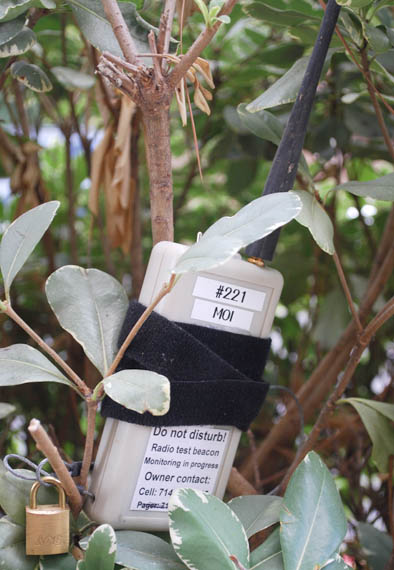
A MicroFox Piccon with added Velcro holding straps, piano wire lanyard and lock.
Rugged Foxbox Construction Notes
In preparation for qualifying runs prior to the 1998 ARDF World Championships, I built six identical two-meter foxboxes. They are still in regular use. Usually, five of them are set out for the ARDF course. The sixth is either a ready spare or serves as the finish-line transmitter on a separate frequency. Occasionally, I use them for mobile transmitter hunts. (A six-fox mobile T-hunt is not uncommon in southern California!) Originally, the foxes were only for two meters. Later, I added small three-watt transmitter boards (ON7YD design) inside for 80 meter ARDF.
IARU regulations permit two-meter championship foxes to run between 250 milliwatts and 1.5 watts. Output powers of all foxes on a course must be within 3 dB of each other and antennas must be identical types at equivalent heights. It's not necessary to follow these rules for local practice hunts, but it's still important to be able to adjust power to suit the course. For hunts in small parks, running less than a half watt will preserve battery life, enabling longer practice sessions. When it's time to try ARDF in a really big park, over a watt may be necessary when a fox is a mile or more away from the start.
The cost of five complete foxboxes built from new name-brand handi-talkies could put a dent in the club treasury, but there are many ways to build them on a shoestring budget. For my own project, the biggest cost savings came by using transmitter boards salvaged from surplus 1980's-vintage 151 MHz business-band mobile transceivers, Yaesu models FTC-1525A and FTC-2025. The price was right (free!) and the boards from these sets are of quality equal to or better than most of today's transmitter kits and homebrew designs.
For surplus transmitters, check local flea markets and business radio suppliers. Get good documentation from the source if at all possible, because manufacturers' prices for old service manuals may be prohibitive. Fortunately, the circuits of sets using discrete semiconductors are relatively easy to trace, even without a schematic.
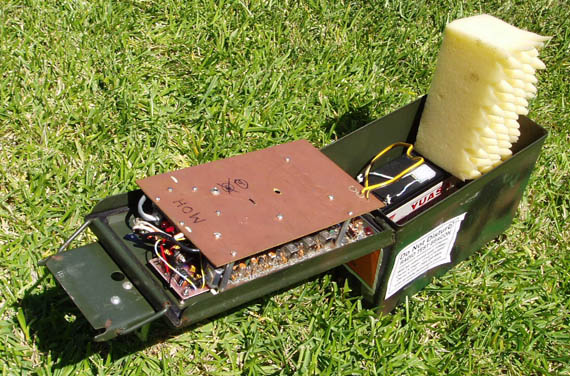
Inside one of my well-worn foxboxes. The circuit board plate provides physical protection for the transmitters boards for 2m and 80m, which are mounted to the lid to minimize flexing cables. A foam wedge holds the battery in place. The 1/8-inch jack is for DTMF audio input to program the PicCon.
For inexpensive, sturdy, waterproof enclosures, it's hard to beat surplus military ammunition boxes. Their dark green color blends well with surroundings. With some grey and black spray paint, you can change this into a "camo" paint job. The size I like (5-1/2 X 11 X 7 inches inside) is twice as big as necessary, but the large surface of the removable lid makes it easy to mount all parts except the battery.
A quarter-wavelength vertical whip antenna, mounted to the lid, will have an adequate ground plane provided by the metal box. The enclosure should be plainly marked as a licensed radio transmitter, with the owner's cell phone or pager number. Add provisions for a bicycle chain and lock to prevent theft.
Flea markets and military surplus outlets are good sources of ammo boxes. You shouldn't have to pay more than about $5 each. Look over the merchandise closely and pick boxes with good lid seals, to keep your transmitter parts dry and prevent corrosion. Protect the equipment inside by mounting parts securely and using foam cushioning. My foxboxes have fallen out of trees more than once, with no damage so far.
Build Them Tough
Over the years, many hams have learned the hard way that Murphy has a special fondness for foxboxes. There are lots of things that can go wrong when you put a hidden transmitter in a remote spot. You cross your fingers hoping that it will come on at the appointed time with full power and that your batteries will last for the duration. You certainly don't want to have to go out to service it, delaying the hunt and possibly giving away its location.
PicCon includes a delayed startup feature that allows you to put out your foxes several hours before the hunt and have them automatically come on at start time. However, just a few milliseconds of power interruption in the interim will reset the timer. There's no way to tell if this has happened until it's too late, so take extra steps to prevent it. I use connectors instead of switches between battery and PicCon. Fuse holders can become intermittent, so I made my own battery fuses out of AWG 32 wire and soldered them into the circuit.
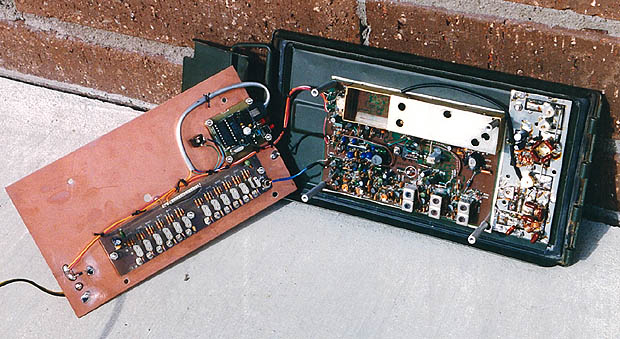
The plate has been separated to show the crystal deck and PicCon. There is a fine-wire fuse in the lower left corner. On the lid are the two meter exciter and final RF stage boards. There is no 80-meter transmitter in this box.
My surplus radios had separate 12-holder crystal boards for receiver and transmitter. I used the transmit crystal boards without the switches to avoid their potential for intermittents. Frequency changes in the field are made by moving one wire. (You do carry a small soldering torch along, don't you?) The coordinated frequency for transmitter hunts in southern California is 146.565 MHz. This frequency is also popular among other cities in the USA and Canada. For hunts where contestants from Europe or Asia are present, a frequency below 146 MHz may be necessary to accommodate their limited-range RDF receivers. I purchased five crystals from Transko, formerly Cal Crystal Lab, in Anaheim, California. You can also try ordering from Bomar in Middlesex, NJ.
The Yaesu transmitter board output originally went to a separate heat-sinked 35-watt final stage. Power from the "barefoot" board exceeds 5 watts, so there is no need to use the battery-wasting finals. An easy and effective way to adjust power on boards like this is to control the supply voltage to the pre-driver, which is the RF stage just preceding the last one on the exciter board. A variable resistor wired as a rheostat will do it, but there would be a large power change as the battery sags during the hunt. In a quick test with a resistor selected to run a FTC-2025 board at 1.5 watts with a nearly charged battery (12.85 volts), the power was only 0.75 watts at near discharge (12.0 volts). A better solution in this case was to use a LM317 IC to regulate the pre-output stage voltage over the range of 3 to 9 volts, sufficient to adjust from 0.1 to 3 watts out of the board. With this regulator, power remains nearly constant as the battery discharges.
Retuning from business band to two meters was a simple matter of installing a new crystal and adjusting each stage from oscillator to output for resonance. The output stage trimmers were set for best efficiency (maximum RF output consistent with minimum current draw). I then used a spectrum analyzer to verify signal stability and purity.
Keep it Clean
Fox transmitters must follow good amateur practice, which includes suppression of spurious emissions and harmonics. There was a filter in the high-power output stage of the transmitters I used, but no such filtering for the preceding stages. Sure enough, the spectrum analyzer showed that the modified FTC-2025 driver output was stable, but its second harmonic was only 16 dB down. So I removed the final stage board from its enclosure in the transceiver and mounted it into the ammo box, unpowered, passing the driver output through just the low-pass filter components. Upon retest, two-meter power was the same but all harmonics were better than -40 dB, in accordance with FCC regulations.
A suitable harmonic filter could be made from scratch on a 2 X 2 inch piece of copper-clad board, using a Dremel(TM) tool to grind pads for the ungrounded component nodes. Below is the schematic and performance curve. Wind each coil on a 15/64-inch drill bit using AWG 20 enamel covered wire, then slide the coil off the bit and install. Turns should not touch each other.
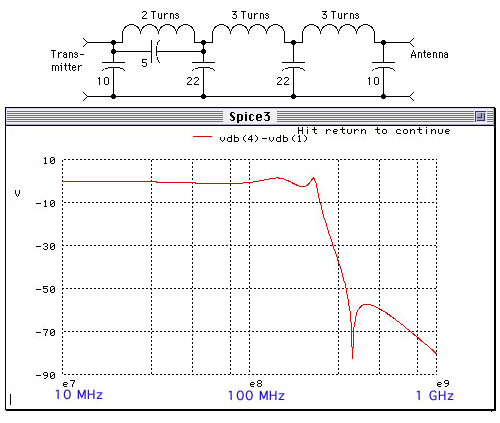
The output of home-built VHF/UHF transmitters should be checked with a spectrum analyzer. If a low-pass filter is needed to prevent harmonic radiation from a two meter transmitter, this circuit will do the job nicely. Capacitance values are in picofarads.
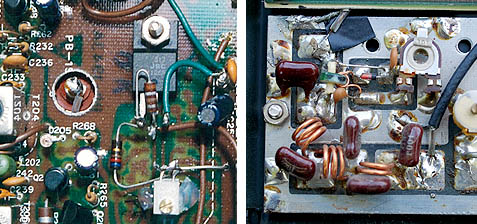
At left, the added LM317 IC and potentiometer provide power regulation and control. Left of the regulator IC is a hole for access to the SO-239 output connector. At right is the lowpass filter section of the final amplifier board. The potentiometer and diode are part of a reflected power sensor circuit that is not needed at three watts or less.
Typical two-watt transmitters for two meters draw between one-half and one Ampere from a 13-volt source, so relays or hefty transistors are needed to key them on and off. I found a small relay on each Yaesu board that was just right for keying. However, its coil draws 40 mA, which is more than the PicCon keying circuit is designed for. Fortunately, the PicCon switching transistor can handle 40 mA, and more base drive for the transistor is available from the PIC chip. Changing R4 on the PicCon from 10K to 910 ohms increased the drive.
Select your batteries in accordance with current drain and anticipated hunt time. Let's say that the transmitter pulls 800 milliamperes at maximum power, including the relay coil. If there are to be five foxes in sequence, the duty of each fox will be 20%, which is 160 mA on average. The PicCon draws 12 mA continuously, so the battery requirement for a 3-hour practice session is 3 X (160+12) = 516 mA-hours. Battery capacity diminishes with age and they last longer if not deep-discharged, so it's best to have 100% safety factor and choose a 1 Ampere-hour or greater battery pack for this example. For full-scale ARDF events, transmitters should have sufficient battery power for at least five hours of operation, because competitors are started at five-minute intervals.
I prefer rechargeable sealed lead-acid (SLA) 12-volt batteries of 4 to 7 ampere-hours capacity, they provide plenty of hunt time without being too heavy to carry into the woods. Before shelling out cash for them, check with the biomedical engineers at your local hospital. Regulations call for periodic replacement of backup batteries in some portable medical devices. You might be able to obtain several used but fully functional SLA packs just for the asking. Another possible source would be computer companies that use SLA batteries in their uninterruptible power supplies.
A simple vertical antenna that's adequate for most small-park hunts is a 19-1/2 inch length of 3/32-inch bronze welding rod in a PL259 plug. I salvaged SO239 connectors from the Yaesu business radios and mounted them near the center of the ammo box lids, for best ground plane performance of the whips. To clear the protruding terminal on the back of the SO239 under the transmitter board, I drilled a half-inch hole in an unused area of each board.
At formal international competitions, horizontal antenna polarization is required for two-meter foxes. Crossed-dipole "turnstile" antennas with proper phasing provide an omnidirectional horizontally-polarized radiation pattern. Plans for simple, rugged two-meter turnstiles are in a legacy Web site of Jay Hennigan WB6RDV (from the "Wayback Machine").
After the solder fumes cleared and the drilling debris was swept up, I added my expenses and discovered that I had spent only $65 per foxbox. The majority of the total cost was for the PicCon controllers. Not bad for a few evenings' work!
There are 43 pages about fox transmitters in my book "Transmitter Hunting -- Radio Direction Finding Simplified."
An Amateur Radio license is required for transmitting with any of these radio foxes.
This site © 2025 Joseph D. Moell. All rights reserved.

 Back to the Homing In home page
Back to the Homing In home page
This page updated 7 July 2025
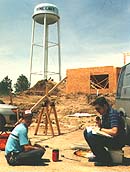 If the club is just getting started in mobile T-hunting, it may be sufficient to use an ordinary handi-talkie or mobile rig and just have someone stay with it and key it up at appropriate intervals. The hider can read into the mike from a book, or from the club newsletter, or just make comments and urge the hunters on, as NØQEC and KBØIEK of the Lincoln (Nebraska) Amateur Radio Club are doing in the photo at left.
If the club is just getting started in mobile T-hunting, it may be sufficient to use an ordinary handi-talkie or mobile rig and just have someone stay with it and key it up at appropriate intervals. The hider can read into the mike from a book, or from the club newsletter, or just make comments and urge the hunters on, as NØQEC and KBØIEK of the Lincoln (Nebraska) Amateur Radio Club are doing in the photo at left.
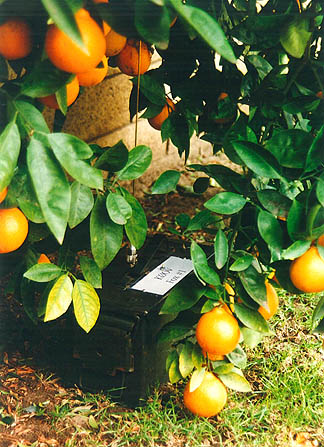 "My club wants to start two-meter transmitter hunting but first we need a hidden transmitter. What is available?"
"My club wants to start two-meter transmitter hunting but first we need a hidden transmitter. What is available?"